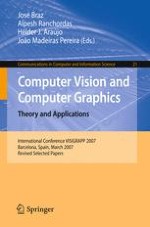This book includes selected papers from VISIGRAPP 2007, the Joint Conference on Computer Vision and Computer Graphics, comprising two component conferences, namely, the International Conference on Computer Vision Theory and Applications (VISAPP) and the International Conference on Computer Graphics Theory and App- cations (GRAPP), held in Barcelona, Spain, during March 8–11, 2007. We received quite a high number of paper submissions: 382 in total for both conf- ences. We had contributions from more than 50 countries in all five continents. This confirms the success and global dimension of these jointly organized conferences. After a rigorous double-blind evaluation method, a total of 78 submissions were accepted as full papers. From those, 18 got selected for inclusion in this book. To ensure the sci- tific quality of the contributions, these were selected from papers that were evaluated with the highest scores by the VISIGRAPP Program Committee members and then they were extended and revised by the authors. Special thanks go to all contributors and re- rees, without whom this book would not have been possible. VISIGRAPP 2007 included four invited keynote lectures, presented by internati- ally recognized researchers. The presentations represented an important contribution to increasing the overall quality of the conference. We would like to express our - preciation to all invited keynote speakers, in alphabetical order: Jake K. Aggarwal (The University of Texas at Austin/USA), André Gagalowicz (INRIA/France), Wo- gang Heidrich (University of British Columbia/Canada), Mel Slater (Universitat Politècnica de Catalunya/Spain).
